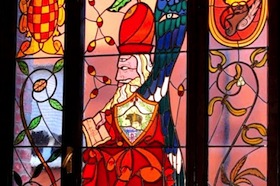-

PALAZZO DEI CAPITANI DELLA MONTAGNA

- Palazzo dei Capitani della Montagna (\"The Mountain Captains' Palace\"), built between the 14th and 15th centuries, served as the headquarters for these public officials, nominated by the Bolognese authorities to govern the area from 1414 to 1796. Today it is used as a Municipal Hall. The front of the building displays a number of 4th - 6th century family crests, including one depicting a wild boar in a swamp encircled by two oak branches tied with a ribbon, which has remained the town's symbol. The current palace was rebuilt after the Second World War, respecting, however, the late 19th century forms that characterized the pre-existing structure, designed in 1885 by Tito Azzolini and Alfonso Rubbiani. The building was further adorned in 1998 with four stained-glass windows created by artist Luigi Ontani. The evocative microcosm of lights and colors, rich in symbolism, that filters through them now illuminates the meeting hall of the Town Council. A work of contemporary art in its own right, the windows exalt and complement the architectural and cultural heritage inherent to this antique palace, which still remains a favored site for tourists.